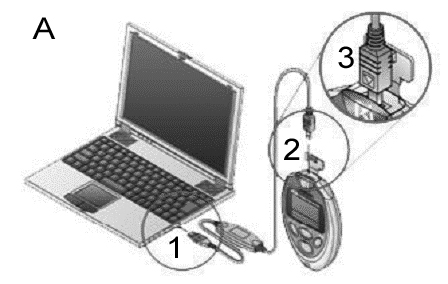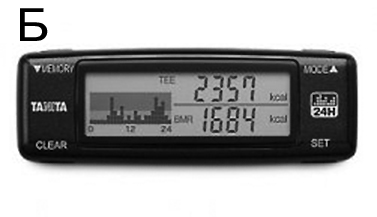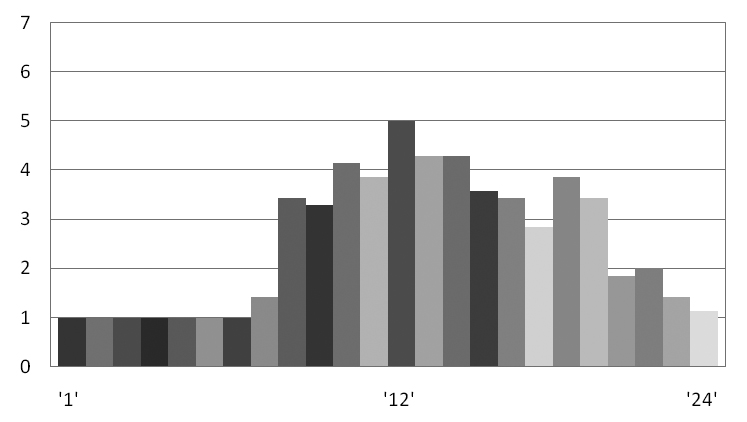MODERN APPROACHES TO THE USE OF PEDOMETER AS A MEAN TO RECORD PHYSICAL ACTIVITY AND TRAIN WALKING HABIT
Фотографии:
ˑ:
A.Yu. Vetoshnikov, postgraduate
A.S. Snigirev, associate professor, Ph.D.
S.I. Loginov, professor, Dr.Biol.
Surgut state university, Surgut
Key words: diagnostics, estimation, indices, device, test.
It is common knowledge that physical activity (PA) is an effective method of prevention of numerous diseases. Regular occupations of moderate intensity decrease the risk of cardiovascular diseases, obesity, diabetes, myocardial infarction and other serious pathological changes in a human body [2, 7, 8, 9]. People need free time and funds which are frequently not enough to do aerobics, shaping and other sports for all, which are popular nowadays in fitness clubs. Independent occupations are more affordable, but need specific knowledge and place to conduct them. Therefore, recently constitutional walk has become popular again in some countries. Constitutional walk is an easy, affordable and practical mean of changing human sedentary life [3, 5]. American and Japanese experts concluded on the given issue that one is to make at least 10000 steps a day to compensate for the sedentary life which most of people lead [4]. Some authors specify the number of steps depending on age and state of health. Thus, D. Bravata et al (2007) recommends that an adult and a young person are to make at least 10000 and 12000 steps respectively to maintain physical condition [3].
The studies were carried out using special sensors - pedometers - miniature devices that record the number of steps made by a person within a certain period of time. It has different modifications, from the simplest step counters to complex electronic devices for three-dimensional registration of motions. Besides the number of made steps, most of the models can calculate the number of calories burnt walking and travelling a distance. So average step length and body weight are determined and the sensor is programmed. All modern pedometers have substantial embedded memory. There are models [6], that can be logged on to a computer and collect data using modern means of communication and internet technologies (Fig. 1, A).


Fig. 1. Internet complex (A) for gathering information on the number of steps a day and energy burnt walking. 1 – connecting a modem to a computer; 2 – connecting a modem to a pedometer; 3 – connection with a satellite dish; B – three-axis pedometer.
In this case all information on the engaged ones can be entered in the computer using special programs with various functions: database creation on the current PA, review of its dynamics; design of the program for body shaping and correction of functional state and many other functions that can be realized on line [7]. The studies on the use of pedometer prove that it is an objective and practical method of assessment of human physical activity [1]. Moreover, pedometer is rather cheap and comfortable [10]. However, the use of a pedometer for scientific purposes needs a correct technique to de designed and the received data to be validated.
A three-axis pedometer was used for the studies (Fig. 1, B) to determine the number of steps a day and a week (7 days), energy consumption (calories or MET), time spent for walking, distance travelled (km).
The subjects recorded the instrument readings in the designed “Journal of results of testing of physical activity” during the whole period of the study, which is adduced below.
JOURNAL
of results of testing of physical activity
Full name ________________________________________
Profession _____________________________________
(pupil, student, employee etc.)
Age _______ Sex (m/f) ______
|
(1 day) date: _____________________ day of week: Steps – _________ (number of steps) Km – _______ (distance travelled) Min – ________ (time of walking) Kcal (TEE) – _______ (overall energy consumption) Kcal (BMR) – _______ (basal metabolic rate) Kcal (AEE) – _______ (energy consumed in physical activity)
|
|||||||||||||||||||||||
|
|
|
|
|
|
|
|
|
|
|
|
|
|
|
|
|
|
|
|
|
|
|
|
|
|
|
|
|
|
|
|
|
|
|
|
|
|
|
|
|
|
|
|
|
|
|
|
|
|
|
|
|
|
|
|
|
|
|
|
|
|
|
|
|
|
|
|
|
|
|
|
|
|
|
|
|
|
|
|
|
|
|
|
|
|
|
|
|
|
|
|
|
|
|
|
|
|
|
|
|
|
|
|
|
|
|
|
|
|
|
|
|
|
|
|
|
|
|
|
|
|
|
|
|
|
|
|
|
|
|
|
|
|
|
|
|
|
|
|
|
|
|
|
|
|
|
|
|
|
|
|
|
|
|
|
|
|
|
|
|
|
|
|
|
|
|
|
|
|
|
|
|
|
|
1 2 3 4 5 6 7 8 9 10 11 12 13 14 15 16 17 18 19 20 21 22 23 24
After seven days of wearing the device, a subject makes a typical diagram, which reflects the value of energy burnt in physical activity in MET (vertical axis - the values ranging from 0 to 7), within the period from midnight up to current time (24 hours - horizontal axis) per day and for seven days in general (Fig. 2) (the data given by G-ko V.D.).

Fig. 2. Intensity of physical loading (MET a day)
One MET is taken as an index of intensity of physical loading sitting and relaxed. The indices equal to the given value are measured by other types of activity (for example, regular walking is estimated by the index of 3 met).
Discussion. Recently there have been many researches with the use of pedometers. So, Strycker et al. (2007) studied the locomotor activity in the form of walking in young healthy girls (n=360) and senior women with type 2 diabetes (n=270). Both of the groups wore pedometers during a week and recorded the steps they made. The girls made 10365 steps on the average. Women with type 2 diabetes - 4352 steps [12]. Here we can conclude that pedometer is to be used both among healthy and sick men of different ages. Vincent et al. also used pedometers (2003). They managed to compare physical activity in the form of walking in residents of different countries and contingents (Table).
Table. The mean values of the number of steps of residents of different countries by Vincent et al. (2003)
|
Number of steps a day |
Subjects |
|
|
Boys |
Girls |
|
|
Australia |
13864 - 15023 |
11221 - 12322 |
|
USA |
12554 - 13872 |
10661 - 11383 |
|
Sweden |
15673 - 18346 |
12041 - 14825 |
As shown on Table 1, generally, boys make more steps than girls. These data correspond with other literature sources [10]. As stated by С. Tudor-Locke et al. (2009), USA residents (mean age - 38) make 10082 steps a day on the average. The number of steps ranges within 5000-6000 a day for the elderly and people with cardiovascular diseases, diabetes and other diseases. С. Tudor-Locke recommends recording the pedometer information for one subject at least for 3 days for further studies of people’s physical activity. However, according to the analysis of literature sources, the information for seven days is used in many researches [2, 6, 10].
These studies are undoubtedly useful. They provide for the objective assessment of physical (locomotor) activity of different population groups. Physical activity of the population can be increased by influencing people via advertisement, television, speeches of scientists, special literature editions, network technologies. There are different ways to motivate to be active. Thus, as reported by A. Marshall et al. (2002), broadsheets on the use of step walking for health, placed in a supermarket, contributed to the increase of the number of stepping up people by 13%, compared to the number of people using an escalator. Control and experimental groups (CG and EG respectively) with the total number of 2767 persons (85% women), mean age 49±9 years took part in the studies of D. Bravata et al. (2007). Participants of the EG have been using pedometers for 18 weeks. As a result, the subjects of the EG started making 2491 steps a day more on the average than the CG (95% confidence interval 1098-3885 steps a day, р<0,001) and 2183 steps a day more compared to their initial level (95% confidence interval 1571-2796 steps a day, р<0,0001). Moreover, systolic pressure (р<0,001) and body mass index (р<0,03) decreased in the EG. The authors mark that the set goal to achieve 10000 steps a day was an important aspect of the increase of physical activity. The findings prove that the use of pedometers significantly increases physical activity and at the same time decreases the body mass index and systolic arterial pressure [3]. D. Merom et al. also consider pedometer as a potential aid in motivating a man to be more physically active by walking [8]. S. Stovitz at al. are of one mind with them [11]. It is obvious that more similar researches need to be made in our country, especially in the regions equated to the Far North due to unfavorable life conditions.
According to the data in the foreign literature [1] and based on personal observations, numerous researchers and practitioners in the field of fitness technologies are assumed to be trying not only to use pedometers widely to get information on the state of physical activity among various population groups, but also consider it as a method of motivation to occupations of constitutional walking and jogging.
References
- Loginov, S.I. Experience of studies of human physical activity using 3-axial pedomaters / S.I. Loginov, A.Yu. Vetoshnikov, Yu.G. Bespalov. Improvement of the system of physical education, sports training and recreation of different population groups: Proceedings of the 11th All-Rus. theor.-pract. conf. / Ed. by. S.I. Loginov. – Surgut: RC SurSU, 2012. – V. II. –. P. 22–25. (In Russian)
- Allenspacha E.C. Patient and physician acceptance of a campaign approach to promoting physical activity: the “Move for Health” project // E.C. Allenspacha [et al.] // Swiss Med. Wkly. – 2007. – V. 137. – P. 292–299.
- Bravata D.M. Using pedometers to increase physical activity and improve health: a systematic review / D.M. Bravata [et al.] // JAMA. – 2007. – 21, N 298(19) – Р. 2296–2304.
- Choi B.C. Achieving the daily step goal of 10,000 steps: the experience of a Canadian family attached to pedometers / B.C. Choi, A.W. Pak, J.C. Choi, E.C. Choi // Clin. Invest. Med. - 2007. – V30, N3 – Р.108–113.
- Craig С.L. Twelve-month effects of Canada on the Move: a population-wide campaign to promote pedometer use and walking / C.L. Craig, C. Tudor-Locke, A. Bauman // Health Educ. Res. – 2007. – V. 22. – P. 406–413.
- Faghri P.D. E-technology and Pedometer Walking Program to Increase Physical Activity at Work / P.D Faghri [et al.] // J Prim Prev. – 2008. – V.29, N1. – P. 73-91.
- Marshall A.L. Randomized trial of three strategies to promote physical activity in general practice // A.L. Marshall [et al.] // Prev. Med. – 2009. – V. 48, N 2. – P. 156–163.
- 8. Merom D. Promoting walking with pedometers in the community: the step-by-step trial / D. Merom [et al.] // Am. J. Prev. Med. – 2010. – V. 32, N 4. – Р. 290–297.
- Richardson C.R. Feasibility of Adding Enhanced Pedometer Feedback to Nutritional Counseling for Weight Loss / C.R Richardson, B.B. Brown, S. Foley, K.S. Dial, J.C. Lowery // J. Med. Internet. Res. – 2005. – V. 7, N 5 – P. 56.
- Scruggs P.W. Middle school physical education physical activity quantification: a pedometer steps/min guideline / P.W. Scruggs // Res. Q. Exerc. Sport. – 2011. – V.78, N4. – Р. 284–929.
- Stovitz S.D. Pedometers as a means to increase ambulatory activity for patients seen at a family medicine clinic / S.D. Stovitz, J.J. VanWormer, B.A. Center, K.L. Bremer // Am. Board Fam. Pract. – 2005. – V.18, N5. – Р. 335–343.
- Strycker L.A. Reliability of pedometer data in samples of youth and older women / L.A. Strycker [et al.] // International Journal of Behavioral Nutrition and Physical Activity. – 2007. V17, N4. – P. 4–10.
- Tudor-Locke C. Correction: Expected values for pedometer-determined physical activity in older populations / C. Tudor-Locke, T.L. Hart, T.L. Washington // Int. J. Behav. Nutr. Phys. Act. – 2009. – V.9, N 6. – P. 65-70.
- Vincent S.D. Activity levels and body mass index of children in the United States, Sweden, and Australia / S.D. Vincent, R.P. Pangrazi, A. Raustorp, L.M. Tomson, T.F. Cuddihy // Med. Sci. Sports Exerc. – 2003. – V. 35, N 8. – P. 1367–1373.



 Журнал "THEORY AND PRACTICE
Журнал "THEORY AND PRACTICE